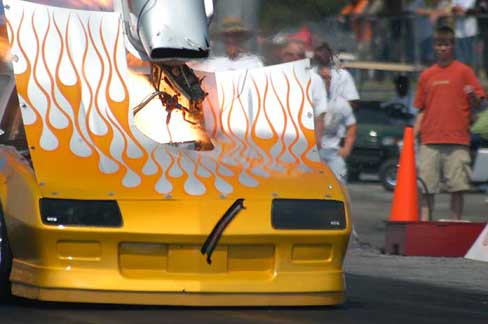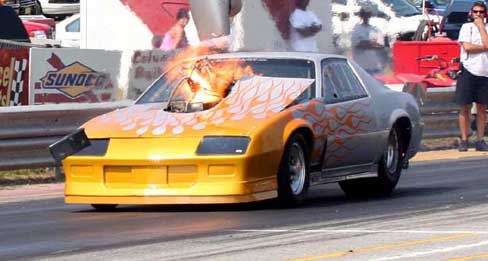
Explosive Decompression
Continued from OUTLAW
ANTI-CLIMAX

When he went to stage, though,
his transbrake wouldn’t hold, so he blipped the throttle
to reset the nitrous timers and tried to leave off the footbrake.
His intake had already loaded up with nitrous, however,
and after a picture-perfect launch Miller suffered a huge
nitrous explosion about 60 feet out that blew both carbs
off the top of the intake and sent his car’s hood
scoop sailing through the air while flying debris also smashed
its windshield.

(Photo by John Fore III, courtesy
of ORSCA)
After the car rolled to a stop, Miller jumped
out, seized an extinguisher from a nearby track worker,
and doused a small fire that remained burning on the engine.
He later said he normally wouldn’t have even tried
to leave after a transbrake failure, “because I know
what can happen,” but felt pressured to attempt to
qualify near the top.
Miller also said the experience taught him
to beef up his onboard fire extinguishing by installing
a second system dedicated to underhood flames, as well as
reconfiguring the interior system to build up more pressure
to disperse the retardant. “The fire wasn’t
inside the car, but I hit the bottle just to make sure,”
Miller said. “And then all it did was get my driving
suit wet.” He later surmised there may be too many
nozzles on the system to build up enough pressure for the
retardant to be effective.
Contacted at his home near Savannah, GA, a
couple of days after the race, Miller said, “We are
still trying to get through all of the carnage. It’s
as bad as I expected, unfortunately.” However, he
assured DRO, “We will be in Huntsville,” Oct.
7-9, for the ORSCA season ender.
(Click here
to return to main story)

